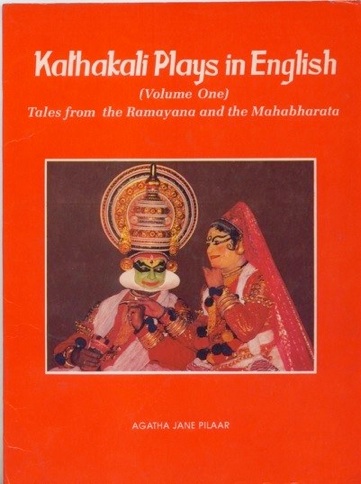Kathakali Plays In English
Volume 1: Tales from the Ramayana and the Mahabharata
Kathakali Plays In English
Volume 1: Tales from the Ramayana and the Mahabharata

My collaborator/translator for the Ramayana-based plays (except for one) was N. K. Panicker, Head of the Department of Malayalam and Sanskrit at Kerala Kalamandalam at the time we worked together (1988-93). Some of these plays are among the earliest ever written, in the Sixteenth Century, collectively called Ramanattam. All eight plays feature Lord Rama, seventh incarnation of great god Vishnu, and/or his arch-enemy, the demon king Ravana.
The four Mahabharata-based plays, which were written at various times between the mid-Seventeenth and the mid-Nineteenth Centuries, feature the five noble Pandava princes and their wicked cousins the Kauravas. For these librettos my collaborator/translator (during 1988-1993) was Kalamandalam K. M. John, Kathakali artist (trained at Kerala Kalamandalam) and teacher—who also translated Torana Yudha, a play based on a Ramayana story.
A Foreword explains my goals and procedure in writing this book and offers guidance to the art and how to enjoy a performance of a Kathakali play.
David Bolland’s brilliant synopses of the two great Indian epic poems are included, with his kind permission, to help the viewer “place” the individual plays in their epic context.
Four colour photos illustrate the make-up and costuming for five of the character types of Kathakali. Black-and-white photos depict action scenes from the plays and show further examples of the magnificent costumes worn by Kathakali artists.
I would suggest to anybody seeing one of these plays (or any other) that it would be helpful to read the brief section, “Preliminaries to the Main Plays” in Volume 4, since these preliminary dance and music items are offered before the main plays at almost all Kathakali performances.
I regret two prominent errors made in Volume 1: first, the erroneous translation of “vadha” as “death” whereas it actually means “slaying” or violent death at the hands of another. Secondly, my failure to cite the source text (used by all my collaborators), which was 101 Attakathakal, edited by S. K. Nair, Anandakuttan Nair and Akkitham, published in two volumes by Sahtya Pravartaka Co-operative Society, Kottayam, in 1979. This is the book used to teach the students at Kerala Kalamandalam the attakkathas (poetical plays the dramatists have written to be set to music), which the singers will sing while the dance-actors enact the lines and the drummers provide appropriate accompaniment. (Everyone on stage must know the attakkathas perfectly.) I regret to say that this error was repeated in Volumes 2, 3 and 4. I have corrected both errors, plus some small typographical errors, for this web edition.
Sruti, a prestigious monthly magazine on the performing arts of India, said in its January 1994 review: "This book will be a great help to those who do not know Malayalam but have a desire to attend and understand Kathakali performances."
NOTE:
All twelve of the Kathakali librettos in this book, including footnotes, published by me in 1993, were stolen and published verbatim without my permission or knowledge by a person named N. K. Singh through his publishing company, Global Vision Publishing House, New Delhi, in 2006. From my book, Kathakali Plays in English, Volume 1: Tales from the Ramayana and the Mahabharata, he put together two sizable and expensive books entitled The Ramayana in Kathakali Dance Drama and The Mahabharata in Kathakali Dance Drama. These forgeries include all my errors plus numerous scanning and editorial ones of his own that distort my work, and not even one of his colour photographs belongs with the play it purports to illustrate—some not even to Kathakali. He copies David Bolland’s synopses of the two epics (which David graciously permitted me to use) without acknowledging his debt, and indeed adds insult to injury by claiming on the front covers of his two books that David Bolland is the translator of the twelve plays written in an ancient, highly-Sanskritized Malayalam which the late Mr. Bolland did not even pretend to know! When copying my footnotes, Singh often gives himself away by inadvertently directing the reader to my Volume 1 by citing my main title (without the subtitle). I trust the other three volumes will not be similarly misused for commercial gain. I am publishing my work on the Internet to enhance the understanding of the art by English-speaking people going to see a Kathakali play or simply interested in this unique art form.
All Photos & Text Copyright 2022 by Agatha Jane Pilaar